Linear stepper motors are pivotal in the realm of precision motion control, offering unparalleled accuracy and repeatability for various applications. In this comprehensive guide, we delve into the intricacies of linear stepper motors, exploring their design, functionality, and applications. By the end of this article, you will have a profound understanding of linear stepper motors, making it easier to choose the right one for your specific needs.
A Linear stepper motor is a type of motor that translates rotational motion into linear motion, enabling precise control over movement along a straight path. Unlike conventional motors, linear stepper motors move in discrete steps, allowing for accurate positioning without the need for feedback systems. This makes them ideal for applications requiring high precision and reliability.
The operation of a Linear stepper motor is based on the principles of electromagnetism. It consists of two main components: the rotor and the stator. The rotor is a permanent magnet or a ferromagnetic material, while the stator contains multiple electromagnets arranged in a specific pattern. When an electrical current is supplied to the stator windings, it creates a magnetic field that interacts with the rotor, causing it to move in discrete steps.
The key advantage of Linear stepper motors is their ability to move in precise, incremental steps. Each step corresponds to a specific angle of rotation, allowing for accurate control over the position and speed of the motor. The number of steps per revolution, also known as the step angle, is determined by the design of the motor and can range from fractions of a degree to several degrees.
To achieve even finer control, many Linear stepper motors employ a technique called microstepping. Microstepping divides each step into smaller sub-steps, resulting in smoother motion and higher resolution. This is particularly useful in applications where ultra-fine positioning is required, such as in semiconductor manufacturing and optical equipment.
External Lead Screw Linear Actuators、Non-Captive Lead Screw Linear Actuator、Ball Screw Linear Actuators、Captive Lead Screw Linear Actuator, Linear Guide Stepper Motor.
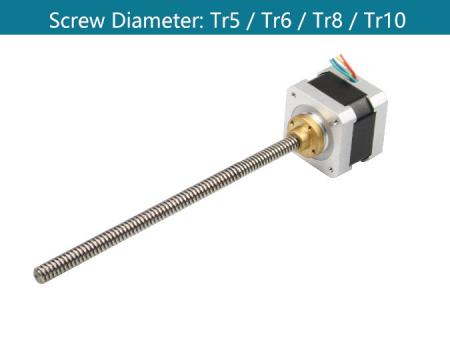 | 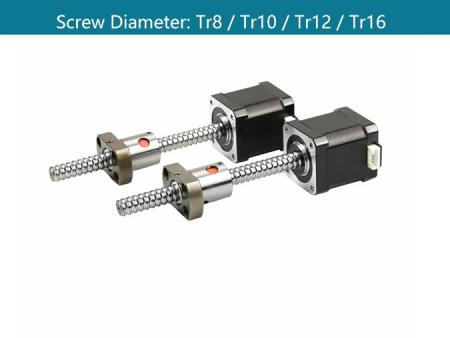 | 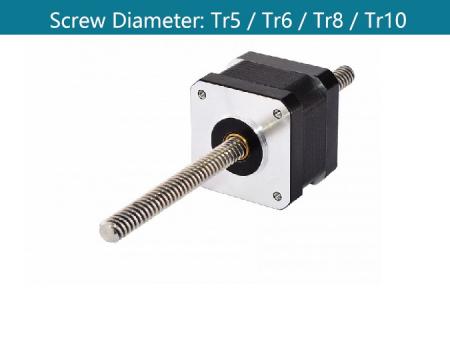 | 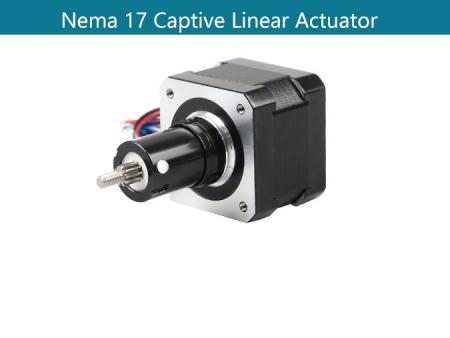 | 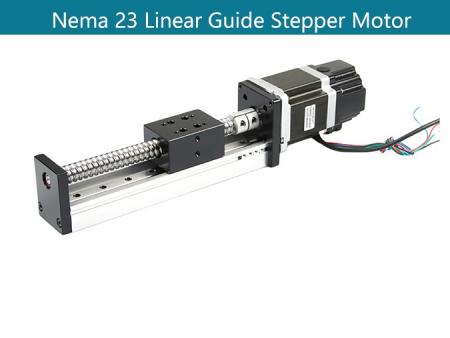 |
| External Lead Screw Linear Actuators | Ball Screw Linear Actuators | Non-Captive Lead Screw Linear Actuator | Captive Lead Screw Linear Actuator | Linear Guide Stepper Motor |
1.External Lead Screw Linear Actuators:
The lead screws of the external Linear stepper motors are integrated with the motor rotor as a part. It has an external drive nut that can be mounted to a carriage assembly. Linear motion is created by the nut traversing back and forth on the lead screw as it turns. The common end feature of the screw is a bearing journal. External linear stepper motors are most akin to motorized rails where the nut is replaced by a driven carriage assembly.
External T-type lead screw linear actuators consist of several key components that work together to provide accurate and reliable linear motion:
1. Lead Screw: The core component, typically made of stainless steel or other durable materials, features a helical thread. This screw drives the linear movement by rotating within a matching nut.
2. T-Nut: The T-nut, or lead nut, engages with the lead screw's threads. As the lead screw rotates, the T-nut moves linearly along the screw, translating rotational motion into linear motion.
3. Motor: A stepper or servo motor is commonly used to drive the lead screw. Stepper motors are preferred for their precision and ability to move in discrete steps, while servo motors are used for applications requiring high speed and torque.
4. Linear Guide: To ensure smooth and stable motion, a linear guide or rail system is often integrated into the actuator. This helps to minimize friction and prevent wobbling or misalignment.
5. Housing: The entire assembly is enclosed in a protective housing that shields the components from dust, debris, and other environmental factors. This housing also helps to maintain the alignment of the lead screw and T-nut.
External T-type lead screw linear actuators offer several advantages, making them a popular choice for precise linear motion applications:
1. High Precision: The helical threads on the lead screw and T-nut provide precise control over linear movement, making these actuators ideal for applications requiring fine positioning.
2. Load Capacity: These actuators can handle significant loads, thanks to the robust design of the lead screw and T-nut. This makes them suitable for heavy-duty applications in industrial settings.
3. Efficiency: The direct conversion of rotational motion to linear motion ensures high efficiency, with minimal energy loss. This results in smooth and consistent motion.
4. Versatility: External T-type lead screw linear actuators can be customized to meet specific application requirements, such as varying lead screw pitches, lengths, and motor types.
5. Reliability: The simple yet effective design of these actuators ensures long-term reliability with minimal maintenance. The enclosed housing protects the components from wear and tear.
These actuators are used across various industries, including:
1. Manufacturing: In CNC machines, 3D printers, and automated assembly lines, these actuators provide precise control over tool positioning and material handling.
2. Medical Devices: They are used in medical imaging equipment, surgical robots, and laboratory automation, where accurate and controlled linear motion is critical.
3. Aerospace: In aerospace applications, these actuators help in positioning control surfaces, landing gear, and other critical components.
4. Robotics: Robotics applications benefit from the precise and repeatable motion provided by these actuators, enhancing the accuracy of robotic arms and positioning systems.
5. Automotive: In the automotive industry, these actuators are used in assembly processes, testing equipment, and various other applications requiring precise linear movement.
External T-type lead screw linear actuators are essential components in many precision motion control applications. Their high precision, load capacity, and versatility make them suitable for a wide range of industries, from manufacturing and medical devices to aerospace and robotics. By understanding their design, advantages, and applications, you can select the right actuator for your specific needs, ensuring optimal performance and reliability.
The nuts of the non-captive linear stepper motors are integrated with the rotor. The lead screw can go through the motor or be completely separated from the motor as a part. It has no reasonable stroke limits but the shaft must be attached to an assembly that will not rotate. This will then allow the lead screw to extend and retract without rotating, travel freely in and out of the motor body. In certain setups the motor body may serve as the drive or the nut in the assembly. The anti-rotation is by the attachments point and is commonly a cut or machine thread on the end of the screw. The non-captive is potentially the shortest overall length assembly.
1. Lead Screw: The main component, typically a precision-machined screw with a helical thread. The lead screw moves linearly as it rotates within the nut.
2. Lead Nut: Engages with the lead screw's threads. The nut remains stationary while the lead screw moves through it.
3. Stepper Motor: Typically used to drive the lead screw, providing precise control over the rotation and, consequently, the linear movement.
4. Motor Housing: Encases the stepper motor and the nut, providing structural support and protection from environmental factors.
The working principle of non-captive Lead Screw Linear Actuator is straightforward:
· When the stepper motor rotates the lead screw, the threaded interaction between the lead screw and the stationary nut causes the lead screw to move linearly.
· The direction of linear movement depends on the direction of rotation of the lead screw.
· The precise control of the stepper motor allows for accurate positioning and repeatable movement.
Non-captive lead screw linear actuators offer several advantages, making them suitable for a wide range of applications:
1. Compact Design: The non-captive design allows for a more compact actuator, ideal for applications with limited space.
2. High Precision: The stepper motor control provides high precision and repeatability, essential for applications requiring accurate linear positioning.
3. Versatility: These actuators can be easily integrated into various systems, offering flexibility in design and application.
4. Simple Installation: The straightforward design simplifies installation and maintenance, reducing downtime and operational costs.
5. Cost-Effective: Non-captive lead screw actuators are generally cost-effective, providing high performance at a reasonable price.
1. Automation and Robotics: In automated systems and robots, these actuators provide precise control for positioning, gripping, and movement tasks.
2. Medical Devices: Used in medical equipment such as infusion pumps, imaging devices, and laboratory instruments, where precise linear motion is critical.
3. Consumer Electronics: In devices like 3D printers and scanners, non-captive lead screw actuators ensure accurate and consistent movement.
4. Industrial Machinery: Employed in machinery for tasks such as material handling, assembly, and inspection, requiring precise linear positioning.
5. Aerospace and Defense: Used in aerospace and defense applications for positioning control surfaces, sensor deployment, and other critical linear movements.
Non-captive lead screw linear actuators are essential components in many precision motion control applications. Their compact design, high precision, and versatility make them ideal for various industries, from automation and medical devices to consumer electronics and industrial machinery. By understanding their design, advantages, and applications, you can select the right non-captive lead screw linear actuator for your specific needs, ensuring optimal performance and reliability.
Ball screws and lead screws are used for different applications and are often not interchangeable. Both have alternate advantages and disadvantages. If you compare a ball screw and lead screw design yourself, the first thing you might notice is that they are designed to carry loads differently. The way ball screws move a load is through recirculating ball bearings to maximize efficiency and minimize friction. A lead screw relies on the amount of friction between surfaces to be low compared to the amount of pressure being applied. That means that a lead screw does not have the same capability to be as efficient as a ball screw. They also provide linear actuators with better performance or faster speeds, depending on which design model you choose.
1. Ball Screw: The central component, featuring a helical groove that accommodates ball bearings. As the screw rotates, the balls roll within the grooves, reducing friction and wear.
2. Ball Nut: Houses the ball bearings and engages with the ball screw. The ball nut translates the rotational motion of the screw into linear motion with high precision.
3. Ball Bearings: Small spherical bearings that roll between the screw and the nut, minimizing friction and ensuring smooth movement.
4. Motor: Typically a stepper or servo motor, which drives the ball screw, providing precise control over the rotational and linear movement.
5. Linear Guide: Ensures stable and accurate linear motion, supporting the load and maintaining alignment.
6. Housing: Encloses the entire assembly, protecting the components from environmental factors and ensuring structural integrity.
The working principle of Ball Screw Linear Actuators is based on the interaction between the ball screw and the ball nut:
· When the motor rotates the ball screw, the ball bearings within the nut roll along the helical grooves of the screw.
· This rolling action significantly reduces friction compared to traditional lead screws, resulting in smooth and efficient linear motion.
· The ball nut moves linearly along the screw as it rotates, translating the rotary motion into precise linear movement.
1. High Precision and Accuracy: The rolling action of the ball bearings ensures minimal backlash and high positioning accuracy, essential for applications requiring precise control.
2. Efficiency: Ball screws provide higher efficiency compared to other types of linear actuators, with up to 90% efficiency due to reduced friction.
3. Load Capacity: Ball screw actuators can handle significant loads, making them ideal for heavy-duty applications.
4. Smooth Operation: The rolling motion of the ball bearings ensures smooth and consistent linear movement, reducing wear and extending the lifespan of the actuator.
5. Durability: The robust design and high-quality materials used in ball screw actuators ensure long-term reliability and minimal maintenance requirements.
1. Industrial Automation: In automated systems, these actuators provide precise control for positioning, material handling, and assembly tasks.
2. Machine Tools: Used in CNC machines, lathes, and milling machines, ball screw actuators ensure accurate and repeatable motion for high-quality machining.
3. Aerospace: In aerospace applications, they are used for controlling control surfaces, landing gear, and other critical components requiring precise linear movement.
4. Medical Equipment: Ball screw actuators are employed in medical devices such as imaging equipment, surgical robots, and patient handling systems, where precision and reliability are crucial.
5. Robotics: In robotic systems, these actuators provide accurate and smooth linear motion, enhancing the performance and capabilities of robotic arms and other components.
6. Automotive: Used in automotive manufacturing and testing equipment, ball screw actuators ensure precise control and positioning in various processes.
Ball screw linear actuators are essential components in many precision motion control applications. Their high precision, efficiency, load capacity, and smooth operation make them ideal for various industries, from industrial automation and machine tools to aerospace and medical equipment. By understanding their design, advantages, and applications, you can select the right ball screw linear actuator for your specific needs, ensuring optimal performance and reliability.
In a captive linear actuator design, the lead screw is connected to a spline shaft that passes through a spline bushing to keep it from rotating. The spline bushing prevents the lead screw from rotating but allows enough clearance for the shaft to move axially as the lead screw is driven back and forth with a corresponding clockwise and counterclockwise turn of the motor. The anti-rotation feature is inherent in the design and creates a stand-alone unit that pushes and pulls whatever device to which it is attached. Because it is independent, this type of captive linear actuator can also provide a push force without being attached to anything. For this reason, it's an excellent choice for packaging applications or push-button applications where the return motion is handled by a spring pre-load or influenced by gravity.Valves used to control the flow of liquids are excellent applications for this product because the captive actuators can easily open and close them with speed control and accuracy. Captive linear actuator can also be used to control airflow in HVAC systems with automated dampers in the ductwork. They work particularly well due to their quiet operation, compact size, and ability to function in dusty/dirty environments.
Captive lead screw linear actuators are precision devices designed to convert rotary motion into controlled linear motion. Unlike other types of lead screw actuators, captive linear actuator incorporate a mechanism that restricts the rotational movement of the nut, ensuring that only linear motion occurs. This makes them ideal for applications where space is limited and precise, reliable linear movement is required.
Captive lead screw linear actuators consist of several key components:
1. Lead Screw: A precision-machined screw with helical threads that interact with the lead nut to create linear motion.
2. Lead Nut: Engages with the lead screw’s threads and moves linearly as the screw rotates. In captive linear actuator, the nut is constrained to prevent rotation.
3. Anti-Rotation Mechanism: Typically a shaft or guide integrated into the design that restricts the nut from rotating, ensuring only linear motion.
4. Stepper Motor: Drives the lead screw, providing precise control over its rotation and, consequently, the linear movement of the nut.
5. Housing: Encases the entire assembly, protecting the components and ensuring structural stability.
The working principle of captive lead screw linear actuators is straightforward:
· The stepper motor rotates the lead screw, which is threaded through the lead nut.
· The anti-rotation mechanism prevents the lead nut from rotating along with the screw.
· As the lead screw rotates, the constrained lead nut moves linearly along the screw’s length, translating rotary motion into precise linear motion.
Captive lead screw linear actuators offer several advantages, making them suitable for a variety of applications:
1. Compact Design: The integrated anti-rotation mechanism allows for a more compact and efficient design, ideal for applications with limited space.
2. High Precision: The controlled linear movement ensures high precision and repeatability, essential for tasks requiring accurate positioning.
3. Ease of Integration: These actuators can be easily integrated into various systems without the need for additional components to prevent nut rotation.
4. Reliability: The simple yet effective design minimizes the potential for mechanical failure, ensuring long-term reliability and minimal maintenance.
5. Cost-Effective: Captive lead screw actuators provide high performance at a reasonable cost, making them an economical choice for many applications.
captive linear actuators are used across a wide range of industries due to their precision, compact size, and reliability. Common applications include:
1. Automation and Robotics: Used in automated systems and robotic devices for precise control of positioning and movement tasks.
2. Medical Devices: Employed in medical equipment such as infusion pumps, diagnostic machines, and laboratory instruments where precise linear motion is crucial.
3. Consumer Electronics: Found in devices like 3D printers, scanners, and other consumer electronics that require accurate and consistent movement.
4. Industrial Machinery: Utilized in machinery for material handling, assembly, and inspection processes requiring precise linear positioning.
5. Aerospace: Applied in aerospace applications for controlling control surfaces, deploying sensors, and other tasks requiring precise linear movement.
Captive lead screw linear actuators are essential components in many precision motion control applications. Their compact design, high precision, and reliability make them ideal for various industries, from automation and medical devices to consumer electronics and industrial machinery. By understanding their design, advantages, and applications, you can select the right captive lead screw linear actuator for your specific needs, ensuring optimal performance and reliability.
1. Stepper Motor: A motor that moves in discrete steps, providing precise control over movement. The stepper motor is responsible for driving the lead screw or belt mechanism.
2. Lead Screw or Belt: Converts the rotational motion of the stepper motor into linear motion. Lead screws are commonly used for applications requiring high precision, while belts are used for higher speed applications.
3. Linear Guide: A mechanical system that ensures smooth and stable linear motion. Linear guides typically consist of rails and carriages that support and guide the moving components.
4. Carriage: The part that moves along the linear guide, carrying the load. The carriage is driven by the lead screw or belt and guided by the linear rails.
5. Housing: Protects the components from dust, debris, and other environmental factors, ensuring the longevity and reliability of the system.
The working principle of Linear Guide Stepper Motors is based on the precise control of the stepper motor and the smooth guidance provided by the linear guide:
· The stepper motor rotates in discrete steps, controlled by an electronic driver.
· The rotational motion is transferred to the lead screw or belt, converting it into linear motion.
· The linear guide ensures that the motion is smooth and stable, preventing wobbling or misalignment.
· The carriage moves along the linear guide, carrying the load with high precision and repeatability.
Linear guide stepper motors offer several advantages, making them suitable for a wide range of applications:
1. High Precision and Accuracy: The stepper motor’s ability to move in discrete steps ensures precise control over movement, while the linear guide provides stable and accurate motion.
2. Smooth Operation: The linear guide ensures smooth and consistent linear movement, reducing friction and wear.
3. Repeatability: Stepper motors provide repeatable motion, which is essential for applications requiring consistent performance.
4. Load Capacity: Linear guides can support significant loads, making these systems suitable for heavy-duty applications.
5. Versatility: Linear guide stepper motors can be used in various applications, from high-precision tasks to high-speed operations.
1. Automation and Robotics: Used in automated systems and robots for precise control of positioning and movement tasks.
2. CNC Machines: In CNC milling, lathes, and routers, these motors ensure accurate and repeatable motion for high-quality machining.
3. 3D Printing: Provide precise control of the print head or bed, ensuring high-quality prints.
4. Medical Devices: Used in medical equipment such as imaging devices, surgical robots, and laboratory instruments, where precise linear motion is critical.
5. Industrial Machinery: Employed in machinery for material handling, assembly, and inspection, requiring precise linear positioning.
6. Semiconductor Manufacturing: Ensure precise and stable motion in the manufacturing of semiconductor devices.
Other types of Linear stepper motors
Linear stepper motors come in various configurations, each designed to meet specific application requirements. Understanding the different types helps in selecting the right motor for your needs. The most common types of linear stepper motors include:
Permanent magnet linear stepper motors utilize a permanent magnet as the rotor. These motors are known for their high torque and efficiency. They are widely used in applications requiring strong and reliable linear motion. Key characteristics include:
· High Torque: Due to the permanent magnet, these motors generate significant torque.
· Efficiency: They are energy-efficient, making them suitable for prolonged use.
· Common Applications: Printers, CNC machines, medical devices, and automation systems.
Variable reluctance Linear stepper motors feature a rotor made of soft iron or similar material. These motors are characterized by their simple construction and cost-effectiveness. Despite offering lower torque compared to permanent magnet motors, they are suitable for applications where high torque is not critical. Key characteristics include:
· Simple Design: Their straightforward design makes them easy to manufacture and maintain.
· Cost-Effective: These motors are economical, making them suitable for budget-conscious applications.
· Common Applications: Valves, actuators, and simple positioning systems.
Hybrid linear stepper motors combine the features of both permanent magnet and variable reluctance motors. They offer a balance of high torque, precision, and efficiency, making them versatile for a wide range of applications. Key characteristics include:
· High Precision: These motors can achieve fine positioning, essential for tasks requiring high accuracy.
· Versatility: Suitable for a variety of applications due to their balanced performance.
· Common Applications: Robotics, automation, laboratory equipment, and semiconductor manufacturing.
Linear actuator stepper motors integrate a linear stepper motor with a mechanical actuator, converting rotational motion directly into linear motion. These motors are ideal for applications requiring direct linear movement without additional mechanical components. Key characteristics include:
· Direct Linear Motion: Eliminates the need for additional conversion mechanisms.
· Compact Design: Integrated design saves space and reduces system complexity.
· Common Applications: 3D printers, medical devices, and laboratory automation.
Tubular Linear stepper motors feature a tubular design where the rotor is a magnetized rod that moves within a set of stator coils. This design offers smooth and precise linear motion, making them suitable for high-precision applications. Key characteristics include:
· Smooth Motion: Provides high-precision and low-friction movement.
· High Resolution: Capable of achieving fine positioning with minimal backlash.
· Common Applications: Precision instruments, optical equipment, and semiconductor handling.
Linear servo stepper motors combine the principles of stepper motors and servo control systems. They offer the precision of stepper motors with the closed-loop control of servos, ensuring accurate and reliable performance. Key characteristics include:
· Closed-Loop Control: Feedback systems ensure precise and accurate motion control.
· High Performance: Suitable for demanding applications requiring both precision and reliability.
· Common Applications: Industrial automation, robotics, and high-precision manufacturing.
Linear stepper motors offer several advantages that make them a preferred choice for precision motion control:
Linear stepper motors provide exceptional precision, with the ability to position loads with sub-micron accuracy. This is crucial in applications where even the slightest deviation can result in errors, such as in semiconductor manufacturing and medical imaging.
The inherent design of Linear stepper motors ensures consistent performance, allowing for repeatable motion with minimal variation. This is essential in industries where consistent and reliable operation is critical, such as in automated assembly lines.
Linear stepper motors have a straightforward design with fewer moving parts compared to traditional motors. This simplicity translates to higher reliability, reduced maintenance, and longer operational life.
Unlike other motor types that require complex feedback systems for precise control, linear stepper motors can operate in an open-loop configuration. This simplifies the control system and reduces overall costs, making them an attractive option for budget-conscious applications.
Linear stepper motors can deliver high torque at low speeds, making them ideal for applications requiring strong and controlled linear motion. This is particularly beneficial in applications such as conveyor systems and industrial machinery.
Linear stepper motors are used across various industries, thanks to their versatility and precision. Some of the most common applications include:
In automation and robotics, Linear stepper motors play a crucial role in achieving precise and repeatable motion. They are used in robotic arms, automated guided vehicles (AGVs), and assembly line equipment to ensure accurate positioning and movement.
Linear stepper motors are widely used in medical devices for their precision and reliability. They are found in imaging equipment, infusion pumps, and surgical robots, where accurate and controlled motion is paramount.
CNC machines rely on Linear stepper motors for precise control over cutting, drilling, and milling operations. The ability to achieve fine positioning allows for intricate and complex machining tasks, ensuring high-quality output.
In the semiconductor industry, Linear stepper motors are essential for wafer handling, lithography, and inspection processes. Their high precision and repeatability are critical in maintaining the stringent tolerances required in semiconductor fabrication.
Linear stepper motors are used in printing and packaging machines to ensure precise movement of print heads, conveyors, and packaging materials. This results in high-quality prints and efficient packaging processes.
Selecting the right linear stepper motor for your application involves considering several factors:
Determine the load that the motor needs to move and choose a motor with sufficient torque to handle it. Consider factors such as weight, friction, and inertia to ensure optimal performance.
Evaluate the precision and resolution required for your application. Higher precision motors with microstepping capabilities are ideal for applications demanding ultra-fine positioning.
Consider the speed and acceleration requirements of your application. Choose a motor that can achieve the desired speed while maintaining accuracy and stability.
Take into account the environmental conditions in which the motor will operate. Factors such as temperature, humidity, and exposure to contaminants can impact the motor's performance and lifespan.
Balance the performance requirements with your budget constraints. While high-performance motors offer superior precision and reliability, they may come at a higher cost.
Linear stepper motors are indispensable components in the world of precision motion control, offering unmatched accuracy, reliability, and versatility. By understanding their working principles, types, advantages, and applications, you can make informed decisions when selecting the right motor for your needs. Whether it's automation, medical devices, CNC machines, or semiconductor manufacturing, linear stepper motors continue to drive innovation and efficiency across various industries.
View More(Total0)Comment Lists